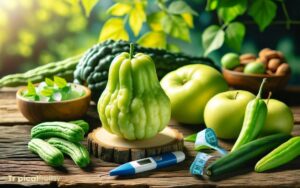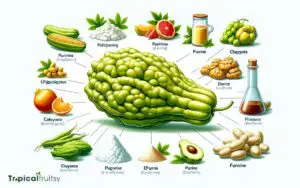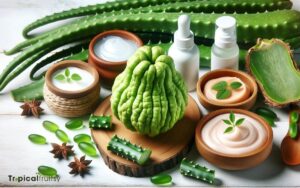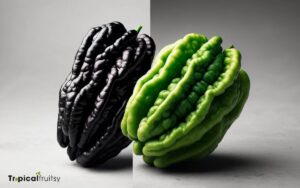How to Grow Chayote in Water? 7 Easy Steps!
To grow chayote in water, start by selecting a healthy chayote fruit. Rinse it and place it in a jar or vase with the bottom half submerged in water.
Change the water every few days to prevent rot. Keep the setup in a warm spot with indirect sunlight. Roots should emerge in a few weeks, after which the chayote can be transplanted to soil.
Chayote, also known as mirliton or choko, is a vine plant that grows in warm climates and produces edible fruit.
Growing chayote in water, also known as hydroponic cultivation, is a simple process that can be done indoors. This method allows the chayote to develop roots before being planted in soil, which can lead to a healthier plant.
Here’s a quick guide:
Starting chayote in water is an easy and efficient way to cultivate new plants, providing a head start to a bountiful harvest.
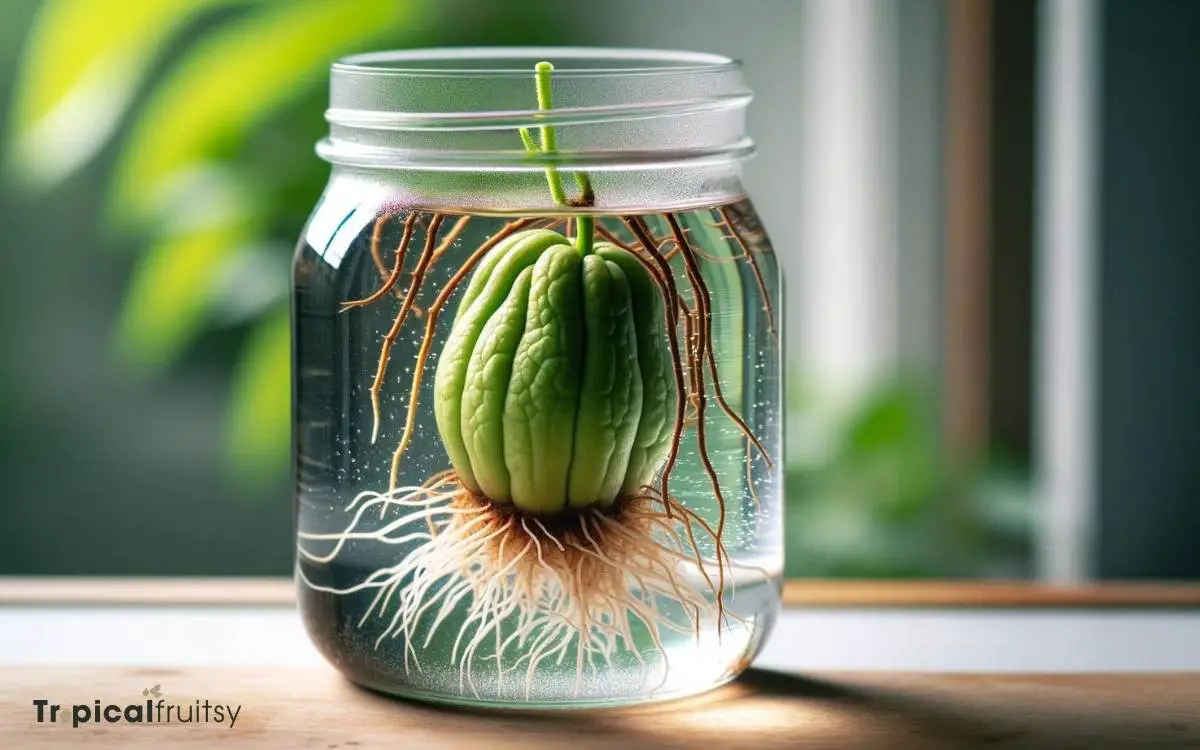
Key Takeaway
Step 1: Selecting Your Chayote
Our initial step involves the selection of a healthy chayote, which is fundamental to the success of hydroponic cultivation.
We prioritize a specimen with a firm texture and a vibrant green hue, indicative of vitality and freshness. The chayote must also possess a mature seed, essential for germination.
We examine the surface for any signs of damage or decay, which could compromise the development process. It’s critical that the chayote hasn’t been chilled, as cold storage can impede sprouting.
We prefer purchasing directly from farmers’ markets to ensure the produce hasn’t undergone temperature-induced dormancy.
Step 2: Preparing the Fruit
We’ll begin by thoroughly washing the chayote to remove any dirt or potential contaminants.
Here’s how we’ll ensure the fruit is properly prepped for water germination:
Inspection
- Examine for bruises or soft spots
- Check for any signs of disease or infestation
Cleansing
- Rinse under running water
- Use a soft brush if necessary
Drying
- Pat dry with a clean cloth
- Allow to air dry briefly
It’s crucial we handle the chayote with care to avoid bruising, which could lead to decay.
By following this methodical approach, we’re setting the stage for a successful germination process, where the clean environment will promote healthy root development without introducing pathogens.
Step 3: Choosing the Right Container
We must ensure the container for our chayote propagation is aptly sized to accommodate the fruit’s growth and root development.
The material of the vessel also plays a critical role, impacting factors such as water retention and temperature stability.
Therefore, we’ll evaluate our options based on these crucial criteria to facilitate optimal growth conditions.
Container Size Matters
Typically, we choose a container that’s at least 8 inches deep and wide to ensure the chayote has ample space to thrive in water.
The right container size is crucial for several reasons:
Root Development:
- Ensures sufficient room for root expansion
- Prevents root crowding, which can stress the plant
- Facilitates better nutrient uptake
Water Stability:
- Larger volume of water doesn’t heat up or cool down as quickly
- Provides a more consistent environment
- Reduces the frequency of water changes needed
Plant Growth:
- Accommodates the size of a mature chayote plant
- Helps maintain the plant’s center of gravity as it grows
- Allows for the addition of support structures if necessary
Selecting the appropriate container is a foundational step in successful chayote cultivation.
Material Considerations
After selecting the proper size, it’s essential that we also consider the material of the container for growing chayote in water.
The container material must be non-toxic and inert, ensuring it doesn’t leach harmful substances into the water that could adversely affect the chayote’s growth.
Glass is an ideal choice, as it’s impervious and doesn’t interact with water or roots. However, if we prefer a more lightweight option, food-grade plastics, specifically those designated with recycling codes 2, 4, or 5, are suitable alternatives.
These plastics are generally considered safe for contact with edibles.
We must avoid containers made of metal or treated wood, which could introduce undesirable elements into the water.
Step 4: Setting Up the Water Environment
We’ll now focus on establishing the optimal water environment, which is critical for the successful cultivation of chayote. We must ensure the water’s pH, nutrient content, and temperature align with the plant’s requirements.
Our guidance will include how to maintain water quality and which containers best support the growth process.
Water Quality Essentials
We’re ensuring optimal growth by carefully monitoring the pH, temperature, and purity of the water in which our chayote will thrive. The pH level is critical; it should remain between 5.5 and 6.5 to allow for optimal nutrient absorption.
To maintain this:
pH:
- Use a digital pH meter for accuracy.
- Adjust with pH up or down solutions.
Temperature consistency is vital as well, ideally kept around 70°F to prevent stress on the plant.
Temperature:
- Employ a water heater for colder environments.
- Monitor with a reliable aquatic thermometer.
Lastly, water purity must be free from contaminants that could hinder growth.
Purity:
- Utilize filtered or distilled water to avoid chlorine.
- Change water weekly to maintain cleanliness.
Container Selection Tips
Choosing the right container is crucial for our chayote’s water-based growth, as it directly impacts the root development and overall health of the plant.
We need a container that’s transparent to observe root growth, but also sturdy enough to support the chayote as it develops.
Here’s a detailed table to help us select the ideal container:
| Container Characteristic | Importance |
|---|---|
| Transparency | Enables monitoring of root development |
| Volume | Sufficient space for root expansion |
| Material | Must be non-toxic and durable |
| Shape | Wide opening for easy access and aeration |
| Stability | Prevents tipping and water spillage |
With our container ready, we’ll set the foundation for a thriving chayote plant. Next, we’ll focus on monitoring growth progress to ensure optimal development.
Step 5: Monitoring Growth Progress
As we monitor the chayote’s growth in water, it’s crucial to regularly check for signs of sprouting and root development.
This process involves:
- Observing the emergence of sprouts
- Inspecting for green shoots at the chayote’s apex
- Assessing shoot vigor and rate of growth
- Tracking root elongation
- Measuring root length periodically
- Noting changes in root thickness and coloration
- Ensuring optimal conditions
- Maintaining adequate water levels
- Adjusting exposure to sunlight as necessary
- Monitoring water temperature to stay within 70-80°F
Step 6: Managing Light and Temperature
To ensure our chayote thrives, we must carefully manage the light exposure and maintain a consistent temperature within the ideal range.
Chayote requires ample light for photosynthesis; however, too much direct sunlight can lead to overheating and dehydration. We aim for a balance, providing bright, indirect light for about 10-12 hours a day.
Regarding temperature, chayote grows best in a warm environment. We monitor ambient conditions, ensuring they remain between 70°F to 80°F. It’s crucial to avoid sudden temperature fluctuations, which can stress the plant.
Here’s a table summarizing our light and temperature guidelines:
| Factor | Ideal Condition | Notes |
|---|---|---|
| Light Exposure | Bright, indirect light | 10-12 hours daily |
| Day Temperature | 70°F – 80°F | Consistent warmth is essential |
| Night Temperature | Slightly cooler than day | Avoid drops below 60°F |
| Light Quality | Full spectrum LED lights | Mimics natural sunlight spectrum |
Step 7: Harvesting Your Chayote
After months of careful nurturing, we’re ready to harvest the chayote, which typically involves checking for maturity by its size and firmness.
Here’s our methodical approach:
Assessing Maturity
- Size: Mature chayote fruits are typically 4 to 8 inches long.
- Firmness: They should yield slightly under pressure, akin to a ripe avocado.
- Appearance: Look for an even green color without blemishes.
When we’re confident the chayotes are ripe, we use clean, sharp shears to cut them from the vine, being cautious not to damage the plant. It’s crucial we handle the fruits gently to prevent bruising.
After harvesting, we store them in a cool, dry place, ensuring they’re not in direct sunlight to maintain their quality until use.
Conclusion
We’ve navigated the waters of chayote cultivation with care, ensuring our green vessel thrived in its aquatic cradle.
Monitoring the growth and adjusting our course with precision, we’ve provided the perfect climate and light to steer our chayote towards a bountiful harvest.
As we reach the end of this journey, it’s clear that patience and meticulous attention to detail are the co-captains that have led us to our destination: a successful water-grown chayote bounty.


